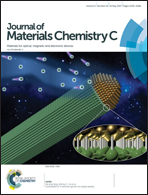Influence of 2,2-bithiophene and thieno[3,2-b] thiophene units on the photovoltaic performance of benzodithiophene-based wide-bandgap polymers†
Abstract
Extending the π-conjugation length of the polymeric backbone is an effective way to enhance the photovoltaic performance of polymer solar cells (PSCs). Here, the donor–donor–acceptor (D–D–A) molecular strategy has been used to design and synthesize two wide-bandgap conjugated copolymers, in which 2,2-bithiophene (BT) or thieno[3,2-b] thiophene (TT) is introduced to the D–A polymer as a third component to investigate the influence of the conjugation backbone on photovoltaic properties. The structure–property relationship and photovoltaic performance of the polymer have been investigated. Compared to P2 (TT as the third unit), P1 (BT as the third unit) exhibits a deeper highest occupied molecular orbital (HOMO) level and a more planar backbone structure with slightly higher mobility. Based on a conventional device structure with PC70BM as the acceptor material, P1-based solar cells exhibit a maximum power conversion efficiency (PCE) of 6.93%, an open-circuit voltage (VOC) of 0.86 V, a short-circuit current (JSC) of 11.06 mA cm−2, and a fill factor (FF) of 72.9%, which are much better than those of P2-based solar cells (PCE 3.92%). These results demonstrate that extending the effective π-conjugation structure of the polymer backbone could improve the photovoltaic performance of PSCs by inserting an additional appropriate donor unit in the D–A polymer.
![Graphical abstract: Influence of 2,2-bithiophene and thieno[3,2-b] thiophene units on the photovoltaic performance of benzodithiophene-based wide-bandgap polymers](/en/Image/Get?imageInfo.ImageType=GA&imageInfo.ImageIdentifier.ManuscriptID=C7TC00720E&imageInfo.ImageIdentifier.Year=2017)


 Please wait while we load your content...
Please wait while we load your content...